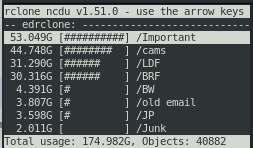A file-hosting service, also known as cloud-storage service, online file-storage provider, or cyberlocker, is an internet hosting service specifically designed to host user files. These services allow users to upload files that can be accessed over the internet after providing a username and password or other authentication. Typically, file hosting services allow HTTP access, and in some cases, FTP access. Other related services include content-displaying hosting services, virtual storage, and remote backup solutions.

MediaFire is a file hosting, file synchronization, and cloud storage service based in Shenandoah, Texas, United States. Founded in June 2006 by Derek Labian and Tom Langridge, the company provides client software for Microsoft Windows, macOS, Linux, Android, iOS, BlackBerry 10, and web browsers. MediaFire has 43 million registered users and attracted 1.3 billion unique visitors to its domains in 2012.
This is a comparison of online backup services.

ExpanDrive is a network filesystem client for MacOS, Microsoft Windows and Linux that facilitates mapping of local volume to many different types of cloud storage. When a server is mounted with ExpanDrive any program can read, write, and manage remote files as if they were stored locally. This is different from most File Transfer Clients because it is integrated into all applications on the operating system. It also does not require a file to be downloaded to access portions of the content. ExpanDrive is commercial software, at a cost of $49.95 per license. A 7-day, unrestricted demo is available for evaluation.

Syncplicity is a file share and synchronization service developed by Syncplicity Inc. The service lets users store and synchronize files between computers. It supports Microsoft Windows and macOS.
Syncovery is backup and file synchronization software that allows backing up and synchronizing files to the same or different drives, to different media, or to a remote server.

GoodSync is a backup and file synchronization program. It is used for synchronizing files between two directories, either on one computer, or between a computer and another storage device or between a computer and a remote computer or server.

Calibre is a cross-platform free and open-source suite of e-book software. Calibre supports organizing existing e-books into virtual libraries, displaying, editing, creating and converting e-books, as well as syncing e-books with a variety of e-readers. Editing books is supported for EPUB and AZW3 formats. Books in other formats like MOBI must first be converted to those formats, if they are to be edited. Calibre also has a large collection of community contributed plugins.
CloudMe is a file storage service operated by CloudMe AB that offers cloud storage, file synchronization and client software. It features a blue folder that appears on all devices with the same content, all files are synchronized between devices. The CloudMe service is offered with a freemium business model and provides encrypted SSL connection with SSL Extended Validation Certificate. CloudMe provides client software for Microsoft Windows, macOS, Linux, Android, iOS, Google TV, Samsung Smart TV, WD TV, Windows Storage Server for NAS and web browsers.
Syncdocs is backup and file synchronization software for Google Drive. Syncdocs uses cloud computing to enable users to back up and synchronize Windows computer files to Google Documents and Google Drive accounts.

Google Cloud Connect was a free cloud computing plug-in for Windows Microsoft Office 2003, 2007 and 2010 that can automatically store and synchronize any Microsoft Word document, PowerPoint presentation, or Excel spreadsheet to Google Docs in Google Docs or Microsoft Office formats. The Google Doc copy is automatically updated each time the Microsoft Office document is saved. Microsoft Office documents can be edited offline and synchronized later when online. Google Cloud Sync maintains previous Microsoft Office document versions and allows multiple users to collaborate, working on the same document at the same time. Google Cloud Connect was discontinued on April 30, 2013, as according to Google, all of Cloud Connect's features are available through Google Drive.

iCloud is a cloud service developed by Apple Inc. Launched on October 12, 2011, iCloud enables users to store and sync data across devices, including Apple Mail, Apple Calendar, Apple Photos, Apple Notes, contacts, settings, backups, and files, to collaborate with other users, and track assets through Find My. It is built into iOS, iPadOS, watchOS, tvOS, macOS, and visionOS. iCloud may additionally be accessed through a limited web interface and Windows application.
Google Drive is a file storage and synchronization service developed by Google. Launched on April 24, 2012, Google Drive allows users to store files in the cloud, synchronize files across devices, and share files. In addition to a web interface, Google Drive offers apps with offline capabilities for Windows and macOS computers, and Android and iOS smartphones and tablets. Google Drive encompasses Google Docs, Google Sheets, and Google Slides, which are a part of the Google Docs Editors office suite that permits collaborative editing of documents, spreadsheets, presentations, drawings, forms, and more. Files created and edited through the Google Docs suite are saved in Google Drive.

@MAX SyncUp is a free proprietary backup and file synchronization program developed by @MAX Software for Windows. It is targeted at individuals and small businesses. The software supports backup to locally writable folders, including attached USB devices, network drives and local directories. It also supports backup and synchronization to WebDAV servers, (S)FTP servers and the cloud storages such as Google Drive and Dropbox.
Tresorit is a cloud storage platform that offers functions for administration, storage, synchronization, and transfer of data using end-to-end encryption. More than 13,000 companies use Tresorit to protect confidential data and share information securely. It is also used widely by Government organizations and NGOs as well as privacy-conscious individuals to protect sensitive data from unauthorized access and data-breaches. As of today, the encryption of Tresorit has never been hacked.
Enterprise file synchronization and sharing refers to software services that enable organizations to securely synchronize and share documents, photos, videos and files from multiple devices with employees, and external customers and partners. Organizations often adopt these technologies to prevent employees from using consumer-based file sharing apps to store, access and manage corporate data that is outside of the IT department’s control and visibility.

MSP360, formerly CloudBerry Lab, is a software and application service provider company that develops online backup, remote desktop and file management products integrated with more than 20 cloud storage providers.

Rclone is an open source, multi threaded, command line computer program to manage or migrate content on cloud and other high latency storage. Its capabilities include sync, transfer, crypt, cache, union, compress and mount. The rclone website lists supported backends including S3 and Google Drive.
AppSheet is an application that provides a no-code development platform for application software, which allows users to create mobile, tablet, and web applications using data sources like Google Drive, DropBox, Office 365, and other cloud-based spreadsheet and database platforms. The platform can be utilized for a broad set of business use cases including project management, customer relationship management, field inspections, and personalized reporting.
NordLocker is a file encryption software integrated with end-to-end encrypted cloud storage. It is available on Windows and macOS. NordLocker is developed by Nord Security, a company behind the NordVPN virtual private network, and is based in the UK and the Netherlands.








